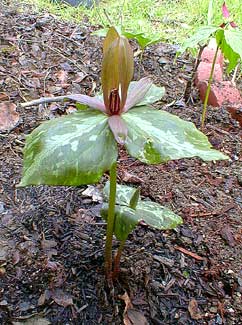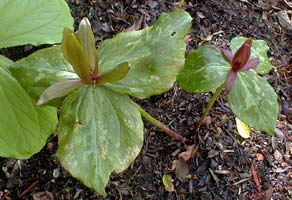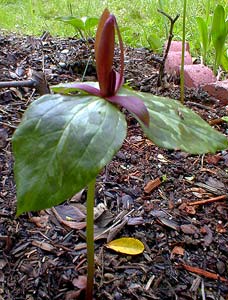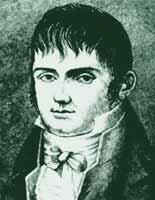
Toadshade, aka
Whipporwill Flower, aka
Sweet Betsy
"Oh, ever thus, from childhood's hour,
I've seen my fondest hopes decay;
I never loved a tree or flower
But 'twas the first to fade away."
-Charles Lamb
(1775-1834)
(1775-1834)
Nine times out of ten (or more like ninety-nine out of a hundred) when you see a plant sold in a garden center as Trillium sessile it is in fact T. cuneatum. The true T. sessile is a dwarf trillium rarely exceeding eight inches in height, flowers only about one-inch small, & leaves to about three inches long. T. cuneatum gets labelled "sessile" which is only correct insofar as the term means that the flowers are attached to the trio of leaves, with no intervening stem. But T. cuneatum is a much larger trillium, reaching ten or twelve inches tall for its early years, & capable of exceeding two feet tall as a well-aged clump; with six inch leaves in youth, ten inch leaves when very mature, & three or four inch flowers. It is by no means a dwarf like T. sessile, though they do look like each other if size is discounted.
We bought three alleged T. sessiles at three different times from three different sources, & they all grew up to be T. cuneatum. I've since spotted such mislabeled plants dozens of times, but only once spotted the relatively scarce T. luteum mislabeled T. cuneteum, & grabbed that immediately.
Two T. cuneteum were planted in a jack-in-the-pulpit garden where they have very slowly multiplied, another is tucked in beside a Wallich's fern, where it develops more slowly due to being in the deepest shade, but also became the largest of the three. The one in the photograph above is shown in early April, in the garden dubbed Pulpit Hill. It grows among several other trillium species, miscellaneous shade plants, & several jack-in-the-pulpit species that for the most part erupt later in the spring than do the trilliums.
 Stemless trilliums are commonly called Toadshades or Toad Trilliums, because their mottled leaves look like frogskins, & the arrangement of leaves lends to the imagination the idea that toads might use them as umbrellas. But trilliums seem invariably to go by many names, & T. cuneatum, native to a great expanse of the southeastern United States, has several names used here & there.
Stemless trilliums are commonly called Toadshades or Toad Trilliums, because their mottled leaves look like frogskins, & the arrangement of leaves lends to the imagination the idea that toads might use them as umbrellas. But trilliums seem invariably to go by many names, & T. cuneatum, native to a great expanse of the southeastern United States, has several names used here & there.It is called Beth Root & Sweet Betsy, names that are actually plays off the more medicinal-sounding name of Birthroot, which several kinds of trilliums have been called because of alleged value within the pharmacopeia of midwifery. It becomes "Sweet" Betsy because T. cuneatum has an unusual fruity odor, which most but not nearly all people find pleasant. It also gets called "Little Sweet Betsy" but the "Little" really ought to be reserved for the true T. sessile which looks identical but is less than half the size.
Most trilliums seem to be called Wake Robin (or Wake-robin) in some places, but mainly only the Toadshades are ever called Whipporwill Flowers, for the same reason that they are said to bloom with the arrival of the earliest birds of spring.
 They are elsetimes called Maroon, Red, or Purple Toadshades because the flowers are in some strains a very nice maroon color, but many more are nearer to chartreuse, ranging from yellowish to greenish, with perhaps a hint of maroon in them. The richest maroon specimens are the most prized for both TT. sessile & cuneatum, but I try not to be too annoyed that most specimens offered are not only mislabeled as sessile but also pretend that they will bloom with the most-desired maroon flowers, when many will in most cases end up with greenish flowers.
They are elsetimes called Maroon, Red, or Purple Toadshades because the flowers are in some strains a very nice maroon color, but many more are nearer to chartreuse, ranging from yellowish to greenish, with perhaps a hint of maroon in them. The richest maroon specimens are the most prized for both TT. sessile & cuneatum, but I try not to be too annoyed that most specimens offered are not only mislabeled as sessile but also pretend that they will bloom with the most-desired maroon flowers, when many will in most cases end up with greenish flowers. Most curiously, however, it can happen that a settled specimen of T. cuneatum that is beginning to clump with more than one flowerl, it can have two distinct kinds of flowers, one type largely green, & the other the sought-after maroon. The second photograph shows this occurring, a large green flower that did not open until it became quite a big separating bud, & a small maroon flower that opened right away & remained quite small.
Additional epithets include Ground Lily & Rose Trillium. Due to the distinct upward curve of the larger type of flower petals, it is occasionally called the Jew's Harp Trillium or Goblet Trillium.
 The species was first described by philosopher-poet-naturalist Constantine Samuel Rafinesque (1783-1840). He is shown in the portrait at left. He was born in Constantinople but came to Philadelphia in 1793 from whence he set out exploring in search of new species of flora & fauna.
The species was first described by philosopher-poet-naturalist Constantine Samuel Rafinesque (1783-1840). He is shown in the portrait at left. He was born in Constantinople but came to Philadelphia in 1793 from whence he set out exploring in search of new species of flora & fauna.In Puget Sound gardens, the Toadshades are up & visible with their young mottled leaves, each triad with a little flower bud at the center, no later than mid-March. The green buds take quite a while to reach full size, so that the earliest open flowers are the first week of April, the majority later in April, & lasting into May. They're hardy down to zone 4, but will not bloom quite so early in colder areas.
The three flower petals do not open flat, but stand upright, with three sepals opened flat atop the leaves. The leaves are a very pretty green with grey-green mottling, & the set of leaves is rarely more than eight inches above the ground. The April photo above shows flowers that are very tall-petalled; this is not a universal trait, as the precise appearance differs over their extensive natural range. Since we didn't get the dwarf trilliums we keep trying for when sold mislabeled, it was nice at least to have these extra-big upright blooms. The purer maroon-blooming specimens I've seen are never so tall in form.
The small bulb with fine roots have long been believed to have medicinal properties, hence the name "Birthroot" shared with a few other species of trilliums. That it is claimed both to be a relaxant & a stimulator is indicative of its value being based to great extent in religion superstition rather than observable outcomes. Because the leaves are arranged in threes & due to the three-petalled blossoms, they have often been regarded as something of an echo of the Christian "trinity," so that mystic qualities & the healing ability of Jesus is conferred upon this humble wildflower, as also upon the shamrock of Ireland.
As a cure-all for lung, pancreatic, liver & kidney disease, dystentary & menstrual hemorrage, & as a fertility herb, it may be regarded one of the herbs with the most exaggerated of unproven powers.